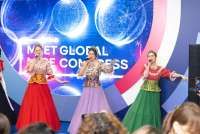This Ramadhan has ushered in new trends in Muslim fashion for women, with styles loosely called “Arzetti”, “Peggy”, “Oki” and “Inneke” taking center stage at Tanah Abang market while last year’s “Syahrini”-style clothes now hang on the sale rack.
In a shop at Tanah Abang market in Central Jakarta, shopper Siti Aminah pointed to a mannequin wearing a dress labeled “Peggy”, a name referring to 1990s actress Peggy Melati Sukma, who regained her popularity after her former husband, businessman Wisnu Tjandra, went missing last month.
Besides Peggy, another mannequin wore a dress labeled “Oki”, referring to actress Oki Setiana Dewi, who rose to fame in her role as Anna in the film Ketika Cinta Bertasbih (When Love is Praying).
Thousands of mannequins dressed in the latest Muslim fashions stood scattered on the third floor of Tanah Abang market’s Blok B to lure the increasing number of shoppers.
Just a few weeks ahead of the Idul Fitri holiday, which will fall in the last week of July, eager shoppers are flocking to thousands of tenants at the market and its surrounding area.
“Oki” and “Peggy” dresses have similar characteristics — soft colors and subtle beading.
“This is simple, but elegant,” shop employee Santi told Siti, pointing at the “Peggy” mannequin.
Shop attendants in the market called this year’s trend syar’i style, which means adhering to religious rules. In fashion, this means wider and longer headscarves and loose, long dresses.
Santi added that the loose dresses would go well with the wide headscarves.
She said she named her mannequins Peggy and Oki because the two celebrities had inspired this year’s trends. She named her other mannequins after other celebrities like “Inneke” (Inneke Koesherawati) and “Arzetti” (Arzetti Bilbina), two other celebrities who sometimes wear loose dresses and large headscarves that cover their chests.
She said that this year’s trends had replaced the kaftan and royal dresses popularized by singer Syahrini.
She said that Syahrini’s style era, which was glamorous and bright, was over.
“I sell Syahrini-style dresses at cheap prices, for less than Rp 100,000 [US$8.39], due to weak demand,” she said.
Santi said that for comparison, she sold syar’i dresses at prices ranging from Rp 260,000 to Rp 350,000.
Most tenants at the market’s Blok B sell the dresses for between Rp 150,000 and Rp 500,000, and some others at less than Rp 150,000.
Similar to women’s fashion this year, Islamic menswear is simpler, with less colorful embroidery than last year.
Controversial Muslim preacher Soleh “Solmed” Mahmud had popularized the trend of long shirts with colorful, intricate embroidery two years ago. As his popularity has gradually decreased amid personal attacks launched against him, men have stopped emulating his style of dress.
However, black, white and brown colors continue to dominate Muslim menswear.
Seller Abdi Muhammad said that he was selling men’s long shirts for Rp 120,000. He would offer discounts to those who bought in large volume.
“I sell one score [20 pieces] of menswear for Rp 1.8 million,” said the seller from Palembang, South Sumatra.
Unlike the outdated Syahrini and Solmed styles, headscarves in the style of Fatin Sidqia Lubis, the winner of singing competition X Factor Indonesia, have risen in popularity.
Fatin is well-known for her multi layer headscarves accented with beads on the left or right side.
Many dress sellers on Jl. Jati Baru, near Tanah Abang market’s Blok B, for example, display head mannequins adorning Fatin-style headscarves.
Uni Evi, a 32-year-old seller from Padang, West Sumatra, said that she sold her headscarves for Rp 25,000. For those buying in large volume, she would offer discounted prices, such as Rp 360,000 per score.
Siti Aminah said that she was attracted to the discounted prices at the market because she wanted to resell them in her hometown of Tasikmalaya, West Java.
“I come to Tanah Abang because I can bargain,” she said.
‘Syahrini’ loses shine, ‘Arzetti’ in vogue
July 03, 2014, 03.56 PM
/2013/01/22/1295886979p.jpg)
ILUSTRASI. Jadwal keberangkatan dan cara naik KRL Solo-Jogja, Sabtu-Minggu, 4-5 Februari 2023
Source: The Jakarta Post
| Editor: Edy Can
Latest News
-
December 29, 2025, 02.23 PM
Asian Stocks Rise, Precious Metals Hit Records on Fed Rate Cut Bets
-
December 27, 2025, 04.19 PM
Moscow Sentences Russian Diplomat to 12 Years for Passing Secrets to U.S Intelligence
-
December 24, 2025, 05.47 PM
MGMC 2025 Highlights Moscow’s Global MICE Readiness—Can Indonesia Follow?
-
December 24, 2025, 05.17 AM
GLOBAL MARKETS-Equities Rise after Strong US Data, Yen Firms on Currency Warnings
-
December 23, 2025, 02.06 PM
Indonesia Expects Normal Wet Season in 2026, Weather Agency Says
-
December 23, 2025, 01.22 PM
GLOBAL MARKETS-Stocks, Precious Metals Rise; Yen on Intervention Watch
-
December 23, 2025, 11.14 AM
Indonesia Eyes US Tariff Deal Signing in January, Says All Issues Settled
-
December 23, 2025, 09.48 AM
Indonesia Trade Negotiator Says All Substantial Issues Settled with U.S.
-
December 22, 2025, 04.15 PM
Indonesia Signs Free Trade Deal with Russian-led Eurasian Economic Union









